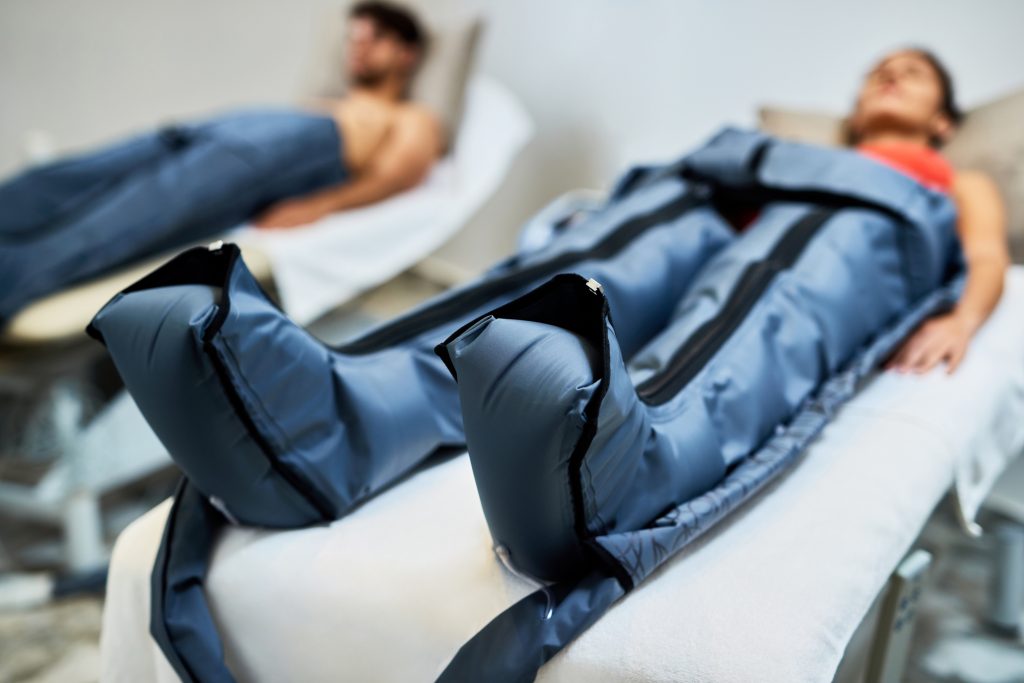Compression boots, often integrated into athletes’ and fitness enthusiasts’ regimens, are an innovative tool designed to enhance blood flow and support recovery. These devices apply sequential compression to the limbs, mimicking the pumping action of muscles, thus aiding in circulation and reducing muscle fatigue post-exercise. They are particularly beneficial after intensive training sessions, where they help in the removal of metabolic waste, leading to quicker recuperation.
While foam rolling is a commonly adopted method for muscle recovery, compression boots provide a more advanced, uniform pressure distribution, which can lead to more effective outcomes. The improved circulation promoted by these boots is essential not just for muscle recovery but also for overall limb health, making them a valuable asset in any fitness toolkit.
Exploring the Mechanisms Behind Compression Boots
Wearing compression boots activates a mechanical process that enhances venous return, a critical component in recovery and overall leg health. A study published in the International Journal of Sports Medicine has shown that this process can lead to decreased muscle stiffness and expedited recovery times, making these boots a staple in the arsenal of recovery tools for athletes.
Understanding How Compression Boots Foster Muscle Recovery
Through a method known as air compression, compression boots deliver rhythmic pressure along the limbs, effectively mimicking the body’s natural muscle contractions. This action facilitates the compression recovery process by stimulating blood flow and hastening the removal of metabolic byproducts that can contribute to muscle soreness and fatigue.
The Role of Compression Boots in Enhancing Blood Circulation
Compression boots offer a significant advantage over traditional compression socks in promoting circulation in the legs. According to the Cleveland Clinic, while compression socks are beneficial for preventing blood clots during prolonged periods of inactivity, compression boots can provide a more dynamic form of therapy, actively enhancing circulation and thus contributing to better overall vascular health.
The Science-Backed Advantages of Compression Boots
Compression socks have long been used to prevent deep vein thrombosis and improve circulation in the legs. However, compression boots take these benefits further by providing a higher degree of pressure and coverage, leading to more pronounced improvements in leg health and recovery times for athletes.
Mitigating Muscle Soreness: The Relief Provided by Compression
A 2015 study showed that compression garments, such as compression socks, can significantly reduce muscle soreness after exercise. By applying consistent pressure, these garments aid in reducing swelling and inflammation, which are common causes of discomfort following intense physical activity.
Boosting Blood Flow and its Impact on Performance
Compression garments are recommended by physical therapists for individuals who spend long periods sitting or standing, as they can help prevent the pooling of blood in the legs. By improving circulation, these garments not only enhance recovery but also contribute to better overall athletic performance.

The Optimal Utilization of Compression Boots
For athletes seeking to optimize recovery, the strategic use of compression boots can be a game-changer. By incorporating them into post-workout routines, they can significantly reduce recovery time, allowing for more effective training sessions.
Maximizing Benefits During Post-Workout Recovery
Post-workout recovery is crucial for athletes, and the integration of compression boots can be as beneficial as foam rolling in mitigating muscle fatigue. Following rigorous training sessions, the use of compression boots can help accelerate the healing process and prepare muscles for upcoming challenges.
Leveraging on Active Recovery Days
On active recovery days, dedicating 20-30 minutes to using compression boots can profoundly affect muscle repair and the removal of lactic acid. This practice not only enhances recovery but also prepares the body for future workouts by ensuring muscles are rested and rejuvenated.
Intensive Training Periods: When to Rely on Compression Boots
During intensive training, muscles are frequently pushed to their limits, leading to increased exercise-induced muscle damage. Compression boots serve as a valuable tool for such periods, providing strategic compression that increases blood flow and aids in flushing out metabolic waste. Athletes may find that using compression devices post-exercise can significantly reduce recovery time, allowing for more efficient training cycles.
Personal Considerations: Tailoring Compression Boot Use to Individual Needs
Every athlete’s body responds differently to training and recovery methods. Individuals need to monitor their responses to compression boots, adjusting usage based on personal comfort, the intensity of the exercise, and specific recovery goals. Some may benefit from daily use, while others might find occasional use sufficient for maintaining peak muscle function.
Practical Insights for Compression Boot Usage
Compression boots are designed to be used as part of a comprehensive recovery strategy. To gain the most benefit, users should combine their use with proper hydration, nutrition, and sleep. While compression boots can be highly effective, they are just one aspect of a holistic approach to recovery and should be used accordingly.
Frequency Matters: Determining How Often to Use Compression Boots
The optimal frequency of using compression boots varies among individuals. However, integrating them into regular post-workout routines can help in consistently mitigating muscle soreness. For those experiencing high levels of muscle fatigue, daily sessions may be beneficial, whereas others might achieve the desired recovery with less frequent use.
Fitting and Adjusting Your Compression Boots for Maximum Effect
Proper fit is crucial for compression boots to be effective. They should snugly encompass the limbs, ensuring even pressure distribution without causing discomfort. Users should follow the manufacturer’s guidelines for fitting and adjusting the boots as needed to maintain a balance between effective compression and comfort.
Addressing Common Questions and Misconceptions
There are many misconceptions surrounding the use of compression boots. Clear communication of research findings and practical user experiences can help dispel myths and provide clarity on the effectiveness of these recovery tools. Users must question claims and seek evidence-based information.
Debunking Myths: What Does the Research Really Say?
Recent studies have shown that compression increases blood flow and can reduce exercise-induced muscle damage. Skeptics may question the efficacy of compression boots, but research generally supports their use as a recovery aid. As with any tool, results can vary, but the consensus points to positive outcomes for many users.
Balancing Tightness and Comfort: How to Ensure Proper Fit
Finding the right balance between tightness and comfort is key to the effective use of compression boots. They should be tight enough to offer therapeutic pressure but not so tight as to cause pain or restrict blood flow. Users should consult sizing charts and make adjustments based on individual limb size and shape.
Beyond Pain Management: Additional Health Perks
While compression boots are renowned for their pain management capabilities, they also offer additional health benefits. By accelerating and enhancing recovery, they contribute to overall well-being, allowing athletes to return to training sooner and with less residual fatigue from previous workouts.
Exploring Vascular and Metabolic Enhancements
The use of compression boots can lead to vascular and metabolic enhancements by improving blood flow and increasing oxygen delivery to muscles. This can result in improved nutrient delivery and waste removal, which are critical factors in muscle repair and building endurance.
Lymphatic Drainage and Compression Boots: A Synergistic Effect
Compression boots aid in lymphatic drainage, a natural process that removes waste products from the body. By enhancing this function, compression boots can help reduce swelling and promote quicker elimination of toxins, contributing to a more efficient recovery process.
Making an Informed Choice: Selecting the Right Compression Boots
When selecting compression boots, it’s important to consider factors such as build quality, pressure settings, and ease of use. A well-informed choice can lead to better recovery experiences and more consistent benefits from the product.
High-quality compression boots are characterized by durable materials, reliable air compression mechanisms, and user-friendly controls. They should also have adjustable settings to cater to various recovery needs and preferences, ensuring a wide range of use cases.
For those seeking the best compression recovery boots, it’s advisable to research and purchase from reputable brands known for their commitment to quality and effectiveness. Specialty sports stores and trusted online retailers are good starting points for finding a suitable pair.
Steps to Ensure Proper Use of Compression Boots
Ensuring proper use of compression boots involves reading the instructional manual thoroughly, adjusting the device to fit securely, and adhering to recommended usage times. Users should start with lower pressure settings and gradually increase as comfort allows, always listening to their body’s response.
Guidelines for a Safe and Effective Compression Boot Experience
To ensure a safe and effective compression boot experience, users should consult with a healthcare professional before starting. This is crucial, especially for individuals with pre-existing conditions such as deep vein thrombosis. Sessions should ideally last between 15 to 30 minutes and the frequency of compression boot usage should be tailored to individual recovery needs. It’s important to wear compression boots properly adjusted to prevent potential negative effects, such as restricting blood flow or causing discomfort. Compression boot sessions should complement active and passive recovery strategies, rather than replace them.

Concluding Thoughts on the Impact of Compression Boots
Compression boots have revolutionized recovery, leveraging the science behind compression boots to enhance the body’s natural healing processes. Embracing compression recovery methods such as compression boots can profoundly transform the recovery experience. These boots support the lymphatic system’s function, prevent fluid from leaking out of small blood vessels, and help reduce blood lactate levels. The result is a notable decrease in muscle pain and quicker recovery times, enabling athletes to return to training with less downtime. The compression prevents excessive protein breakdown while promoting protein synthesis, further cementing compression boots as a valuable tool in recovery protocols.
